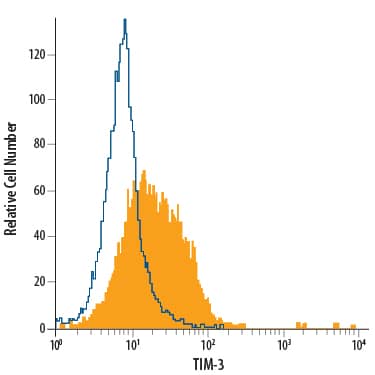Mouse TIM-3 PE-conjugated Antibody
R&D Systems, part of Bio-Techne | Catalog # FAB1529P

Key Product Details
Species Reactivity
Validated:
Cited:
Applications
Validated:
Cited:
Label
Antibody Source
Product Specifications
Immunogen
Arg20-Ala193
Accession # Q8VIM0
Specificity
Clonality
Host
Isotype
Scientific Data Images for Mouse TIM-3 PE-conjugated Antibody
Detection of TIM‑3 in RAW 264.7 Mouse Cell Line by Flow Cytometry.
RAW 264.7 mouse monocyte/macrophage cell line was stained with Rat Anti-Mouse TIM-3 PE-conjugated Monoclonal Antibody (Catalog # FAB1529P, filled histogram) or isotype control antibody (Catalog # IC006P, open histogram). View our protocol for Staining Membrane-associated Proteins.Applications for Mouse TIM-3 PE-conjugated Antibody
Flow Cytometry
Sample: RAW 264.7 mouse monocyte/macrophage cell line
Reviewed Applications
Read 1 review rated 5 using FAB1529P in the following applications:
Formulation, Preparation, and Storage
Purification
Formulation
Shipping
Stability & Storage
- 12 months from date of receipt, 2 to 8 °C as supplied.
Background: TIM-3
TIM-3 (T cell immunoglobulin and mucin domain-3) is a 60 kDa member of the TIM family of immune regulating molecules. TIMs are type I transmembrane glycoproteins with one Ig-like V-type domain and a Ser/Thr-rich mucin stalk (1 - 3). There are three TIM genes in human and eight in mouse. Mature mouse TIM-3 consists of a 174 aa extracellular domain (ECD), a 21 aa transmembrane segment (TM), and a 67 aa cytoplasmic tail (4). Two alternately spliced isoforms have been reported in mouse which lack either the TM or both the TM and mucin regions (5, 6). Within the ECD, mouse TIM-3 shares 58% and 74% aa sequence identity with human and rat TIM-3, respectively. TIM-3 is specifically expressed on Th1 cells whereas TIM-1 and TIM-2 are expressed on TH2 cells. In chronic inflammation, autoimmune disorders, and some cancers, TIM-3 is upregulated on several other hematopoietic cell types and on hippocampal neurons (9 - 12). The glycosylated Ig domain of TIM-3 binds cell-associated galectin-9 which induces TIM-3 Tyr phosphorylation and proapoptotic signaling(10, 13). TIM-3 functions as a negative regulator of Th1 cell activity. Its blockade results in increased IFN-gamma production, Th1 cell proliferation, and cytotoxicity (5, 7, 12, 14). TIM-3 may play a role in regulatory T cell development, (7) inflammation, (15) and immune tolerance (5, 13, 14). Soluble mouse TIM-3 has been shown to inhibit anti-tumor effector T cell responses and to enhance autoimmune reactions (6, 7).
References
- Anderson, A.C. and D.E. Anderson (2006) Curr. Opin. Immunol. 18:665.
- Mariat, C. et al. (2005) Phil. Trans. R. Soc. B 360:1681.
- Meyers, J.H. et al. (2005) Trends Mol. Med. 11:362.
- Monney, L. et al. (2002) Nature 415:536.
- Sabatos, C.A. et al. (2003) Nat. Immunol. 4:1102.
- Geng, H. et al. (2006) J. Immunol. 176:1411.
- Sanchez-Fueyo, A. et al. (2003) Nat. Immunol. 4:1093.
- Khademi, M. et al. (2004) J. Immunol. 172:7169.
- Wiener, Z. et al. (2007) J. Invest. Dermatol. 127:906.
- van de Weyer, P.S. et al. (2006) Biochem. Biophys. Res. Commun. 351:571.
- Gielen, A.W. et al. (2005) J. Neuroimmunol. 164:93.
- Oikawa, T. et al. (2006) J. Immunol. 177:4281.
- Zhu, C. et al. (2005) Nat. Immunol. 6:1245.
- Koguchi, K. et al. (2006) J. Exp. Med. 203:1413.
- Frisancho-Kiss, S. et al. (2006) J. Immunol. 176:6411.
Long Name
Alternate Names
Entrez Gene IDs
Gene Symbol
UniProt
Additional TIM-3 Products
Product Documents for Mouse TIM-3 PE-conjugated Antibody
Product Specific Notices for Mouse TIM-3 PE-conjugated Antibody
For research use only
